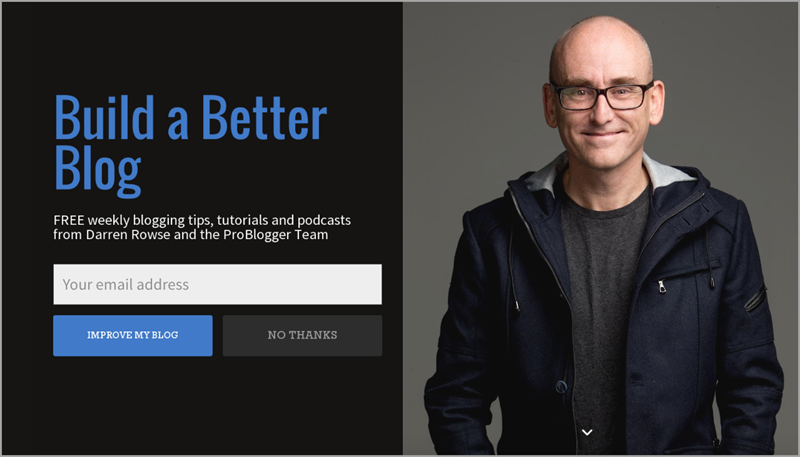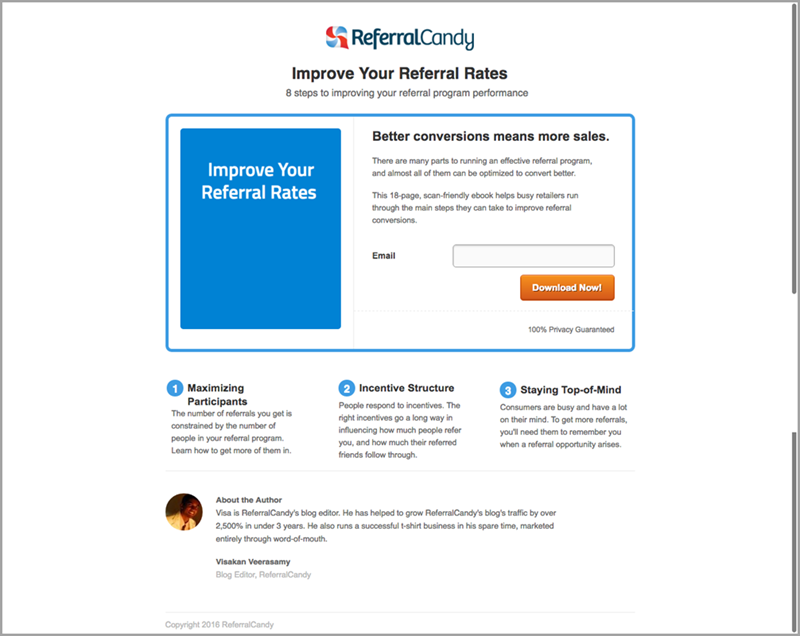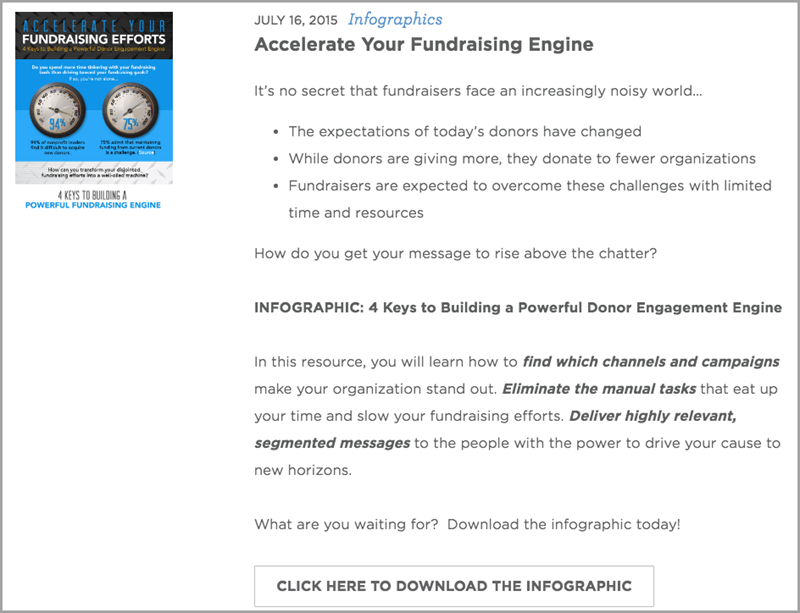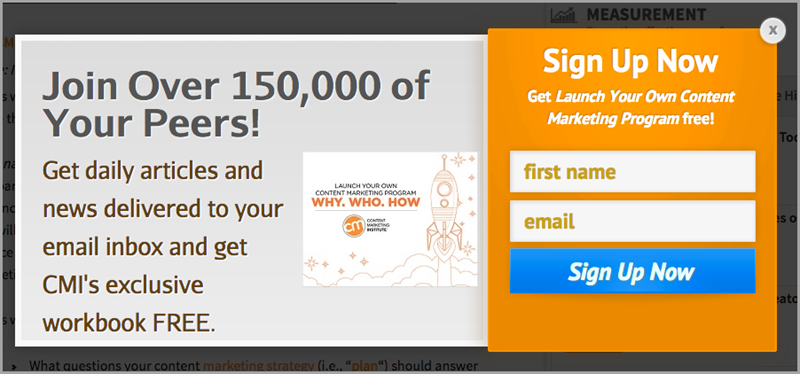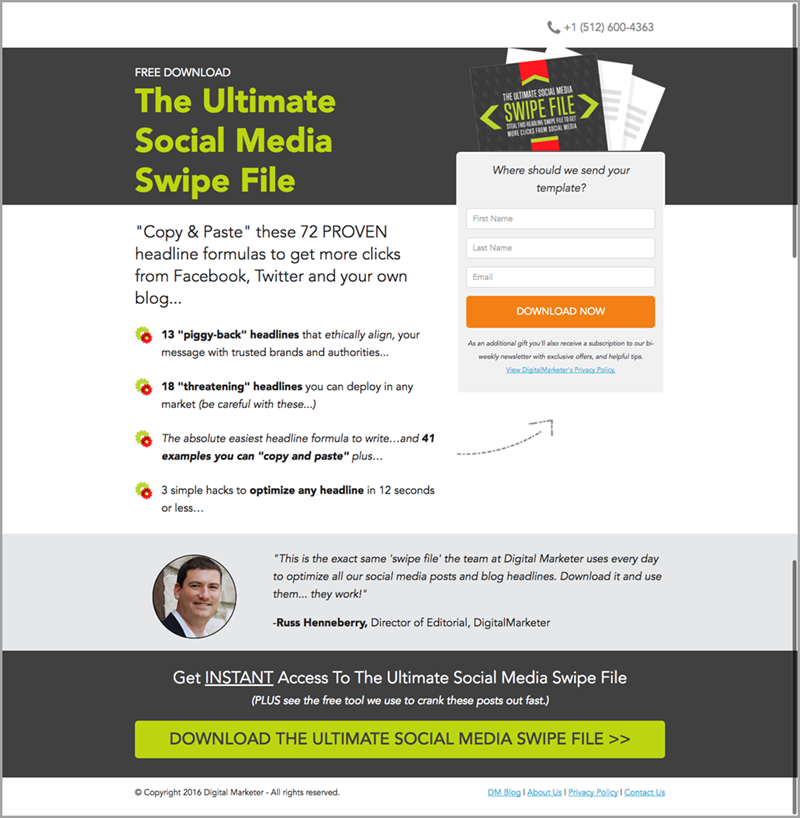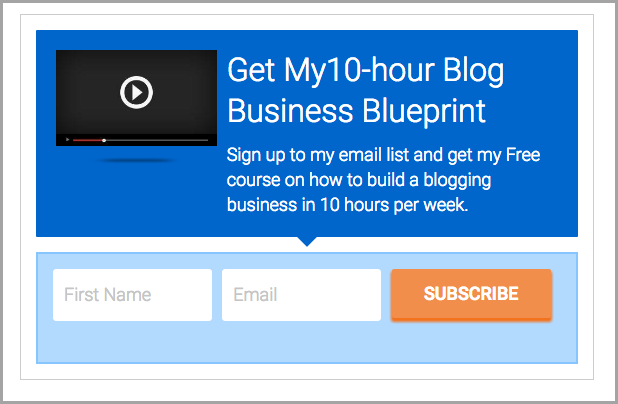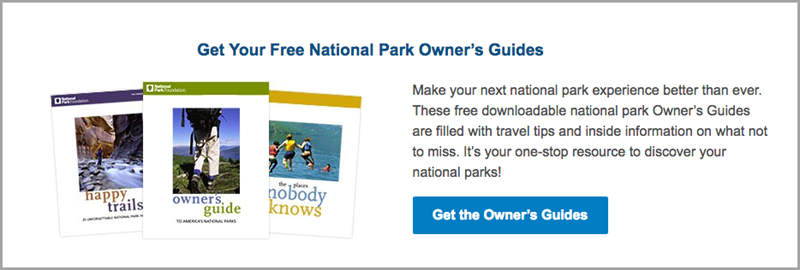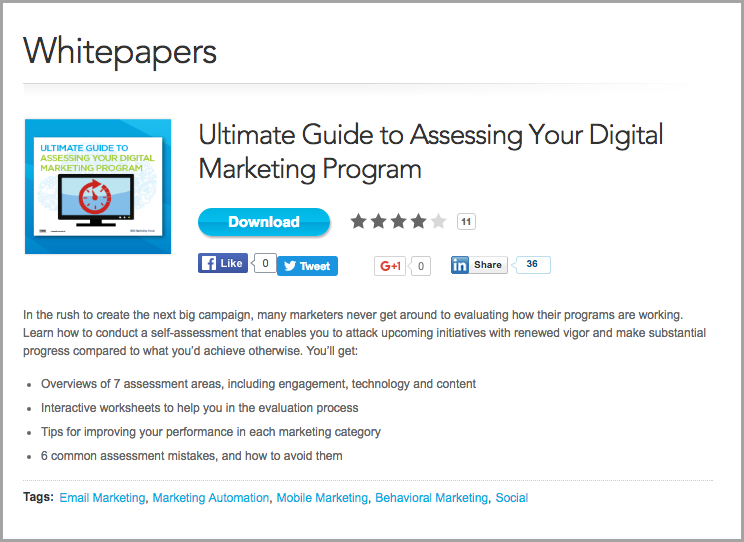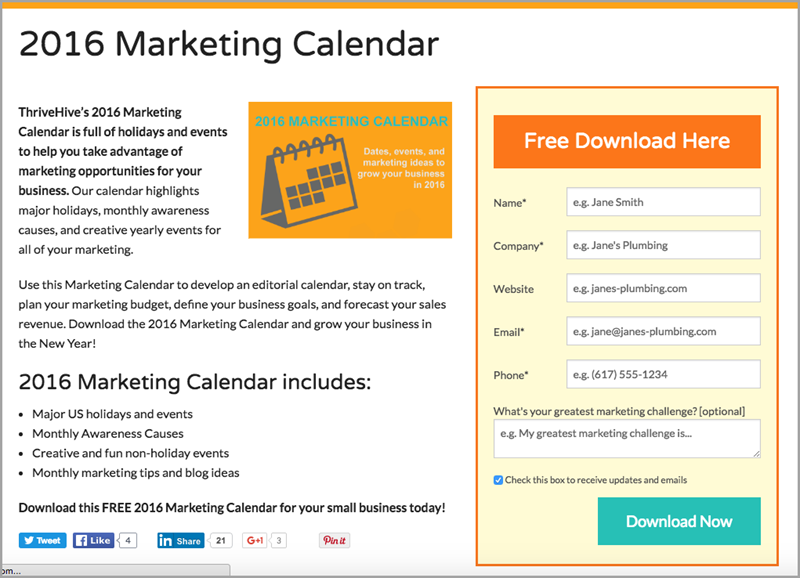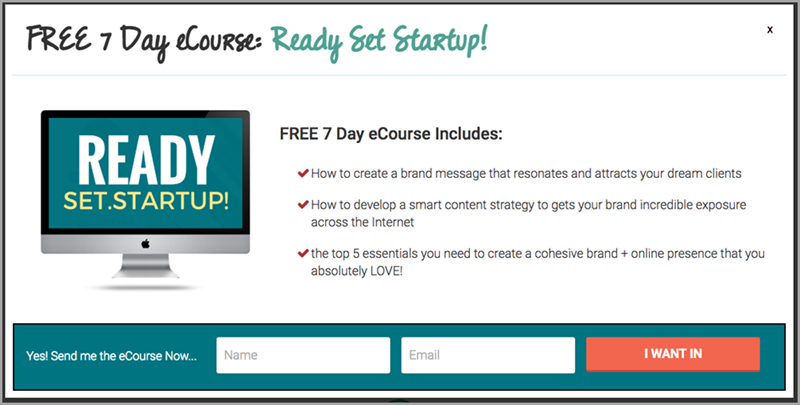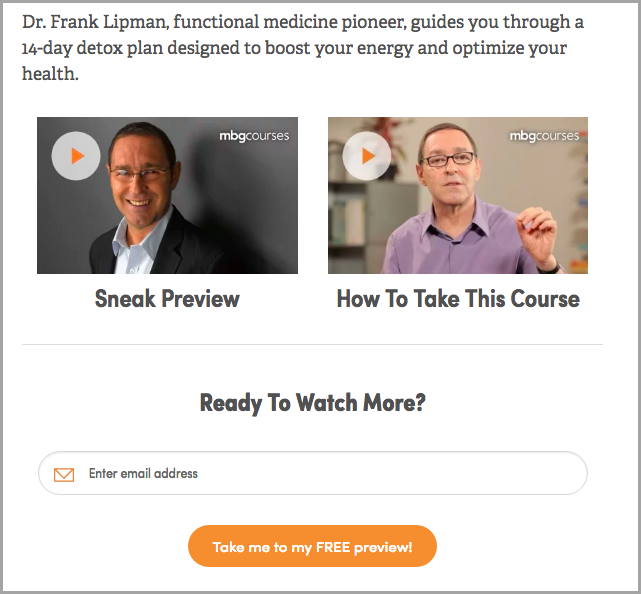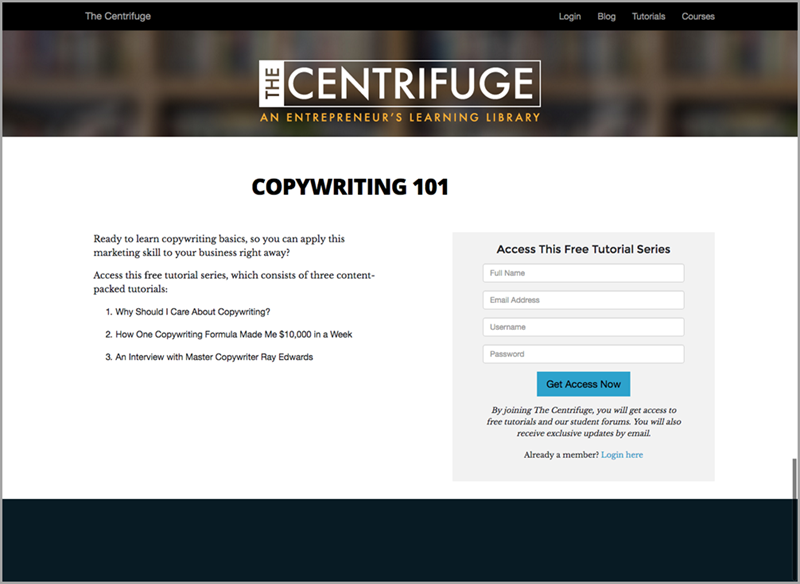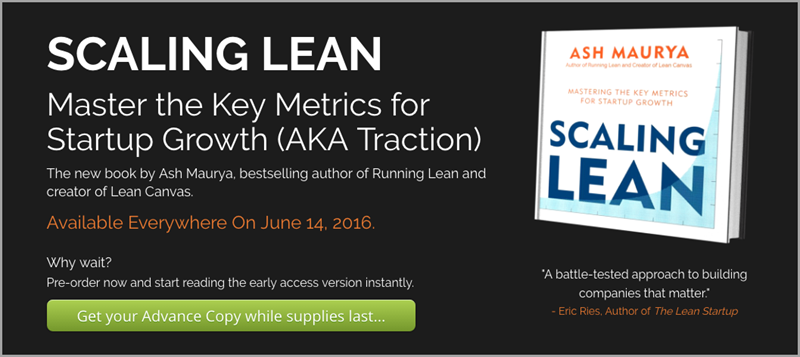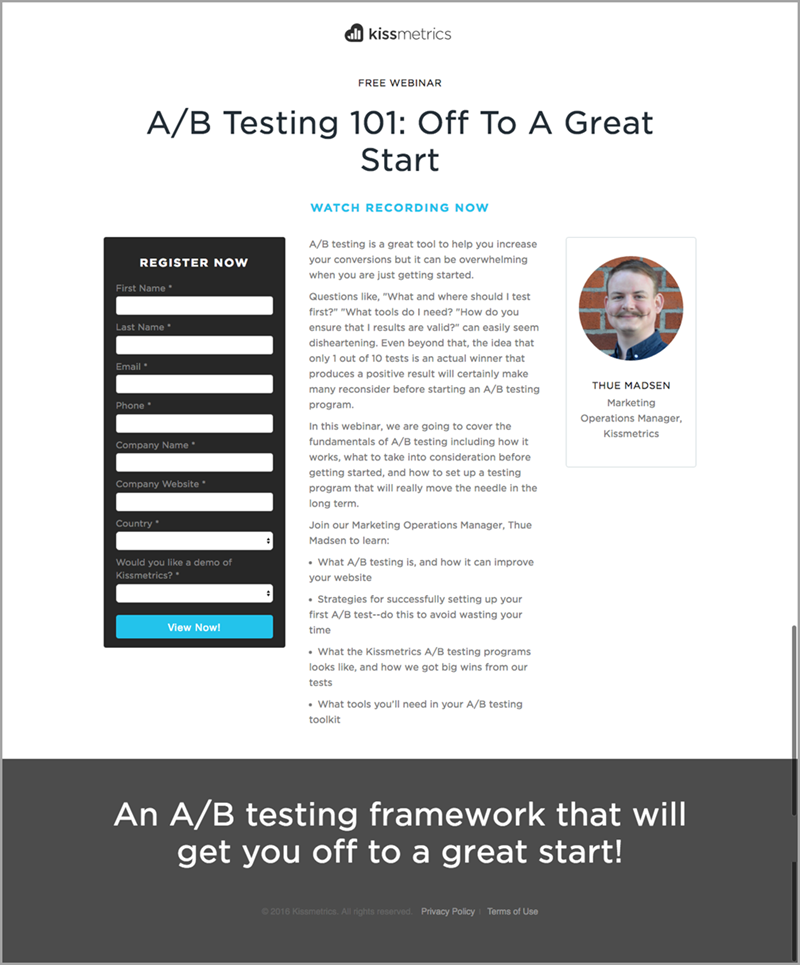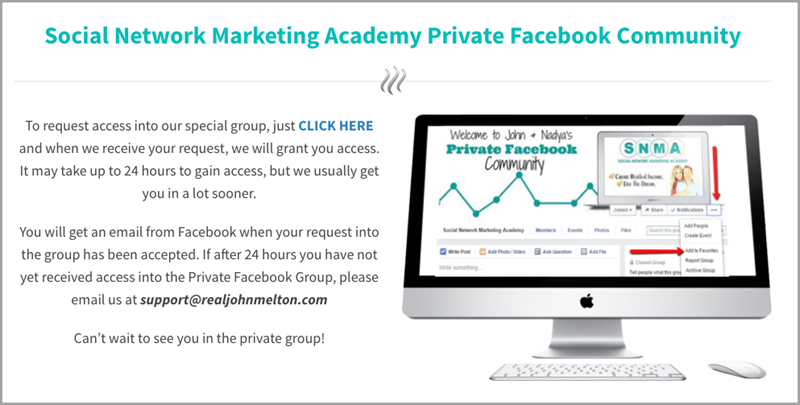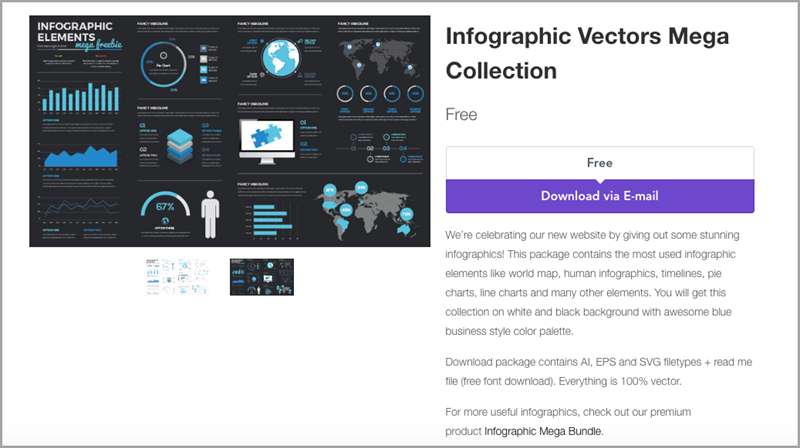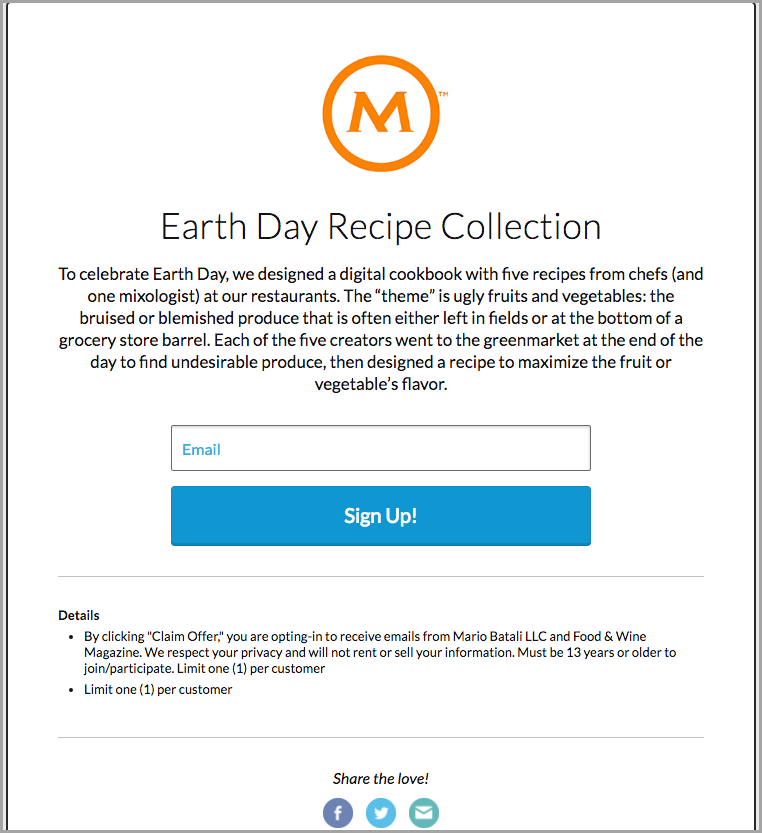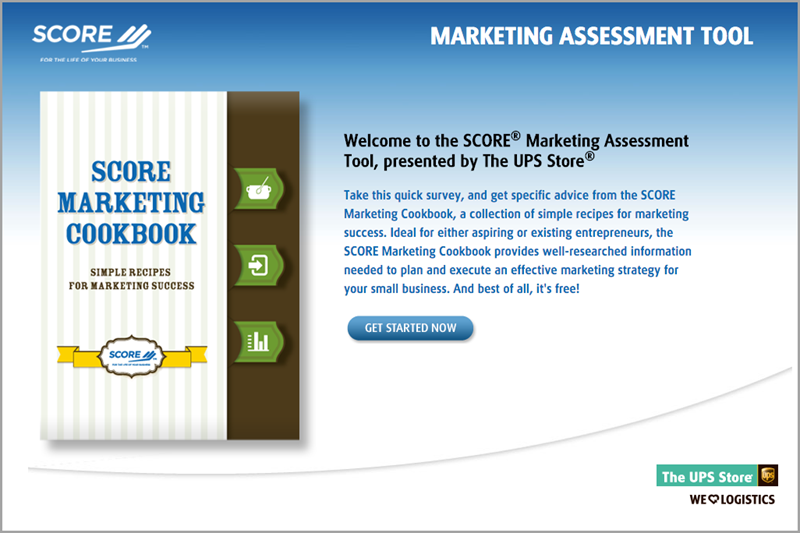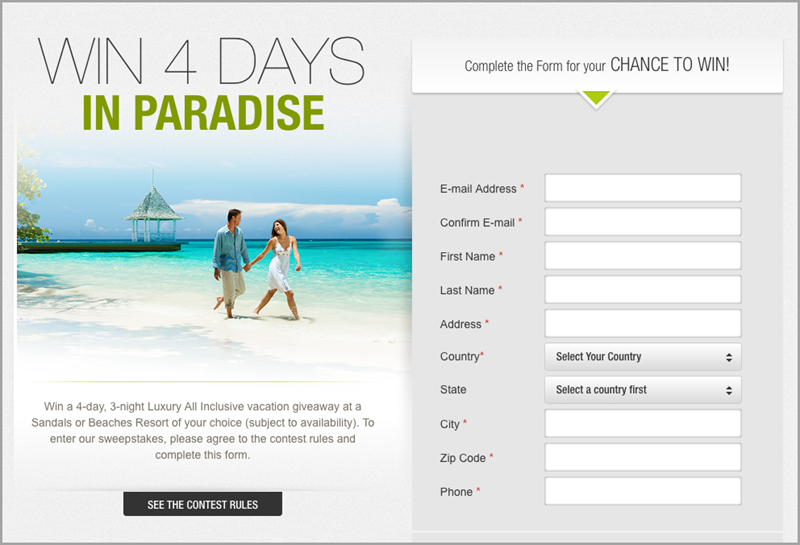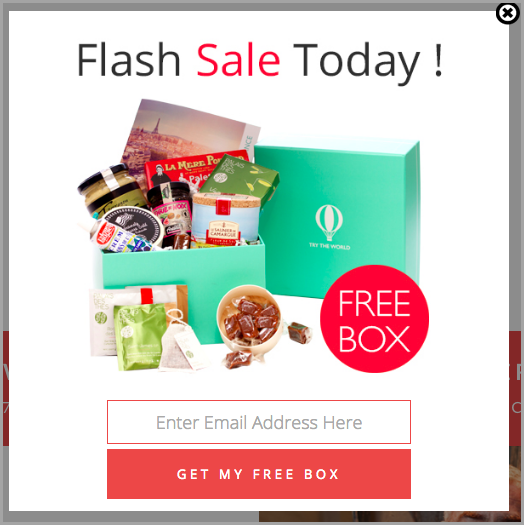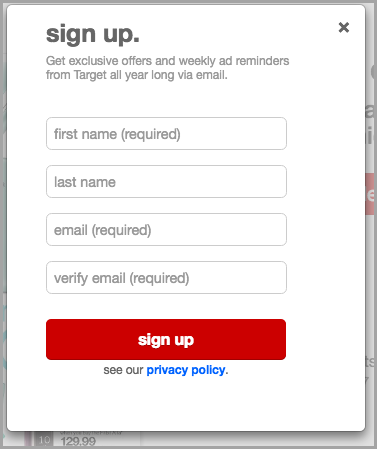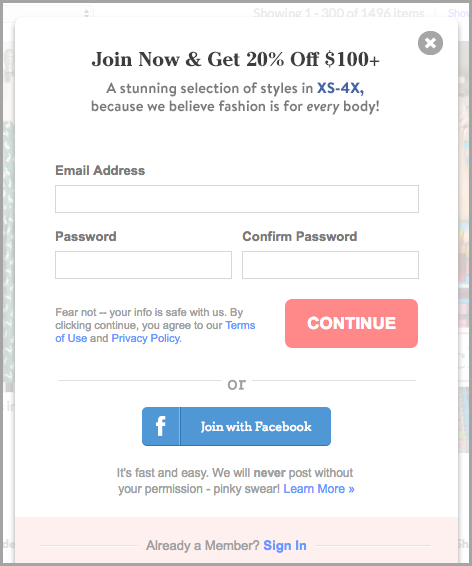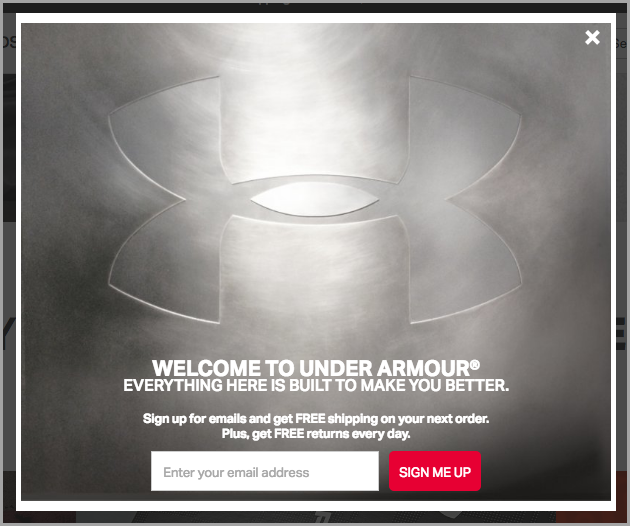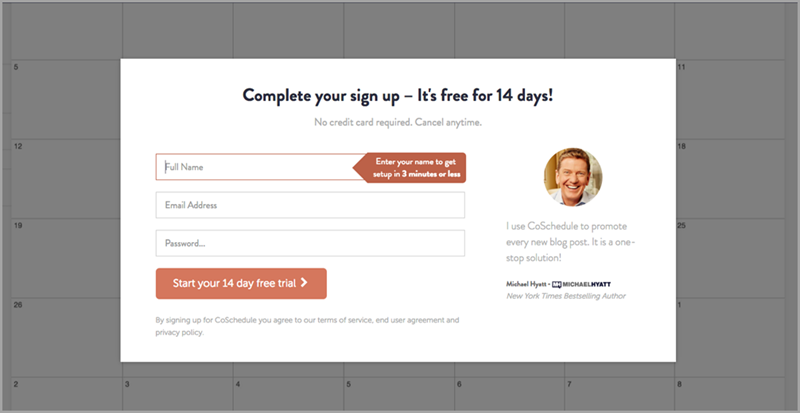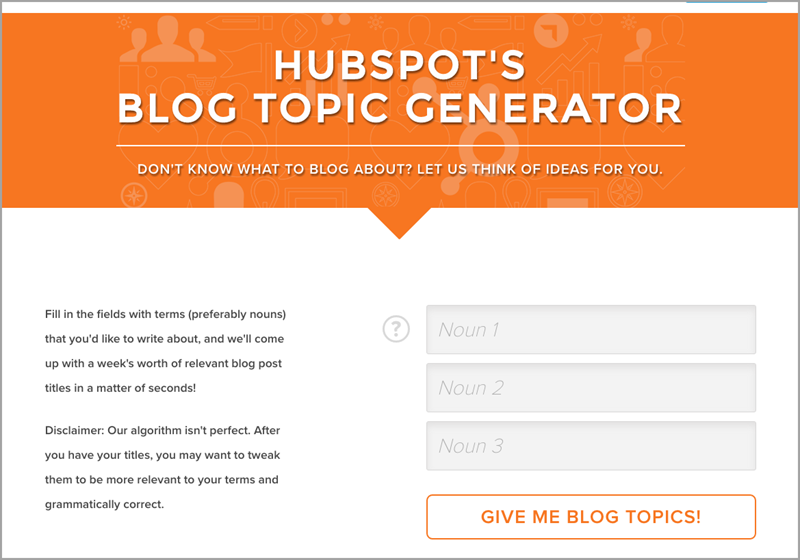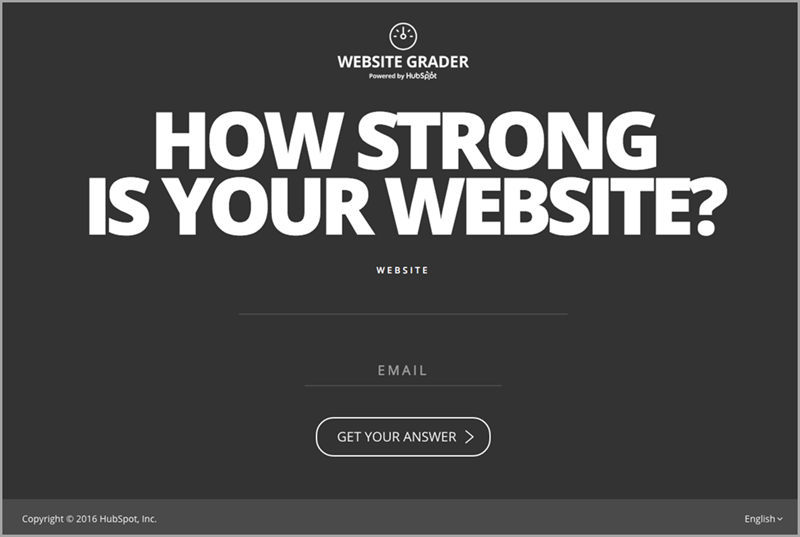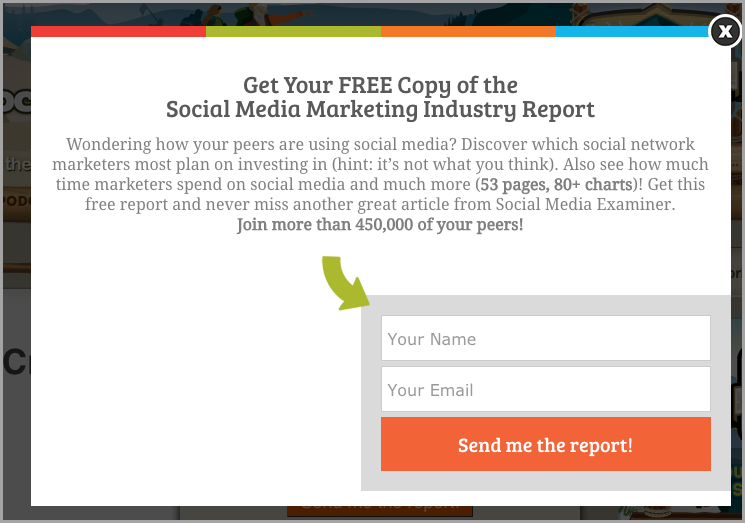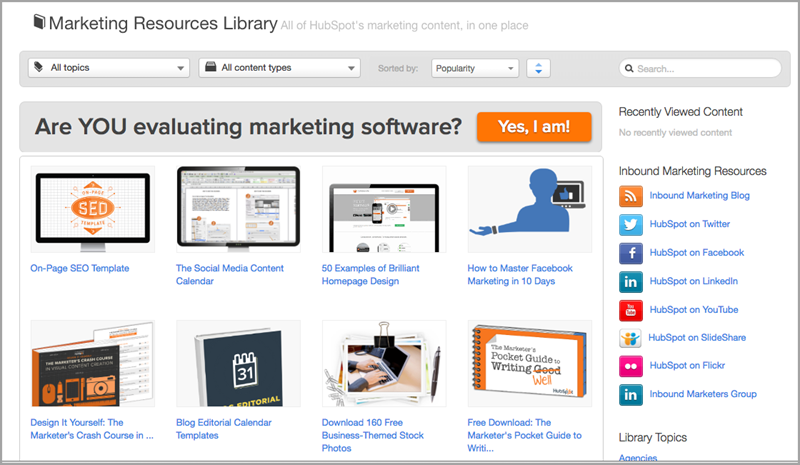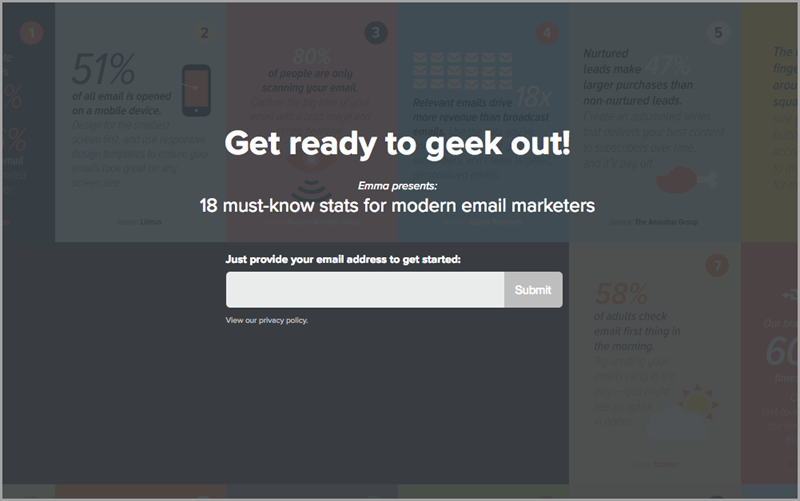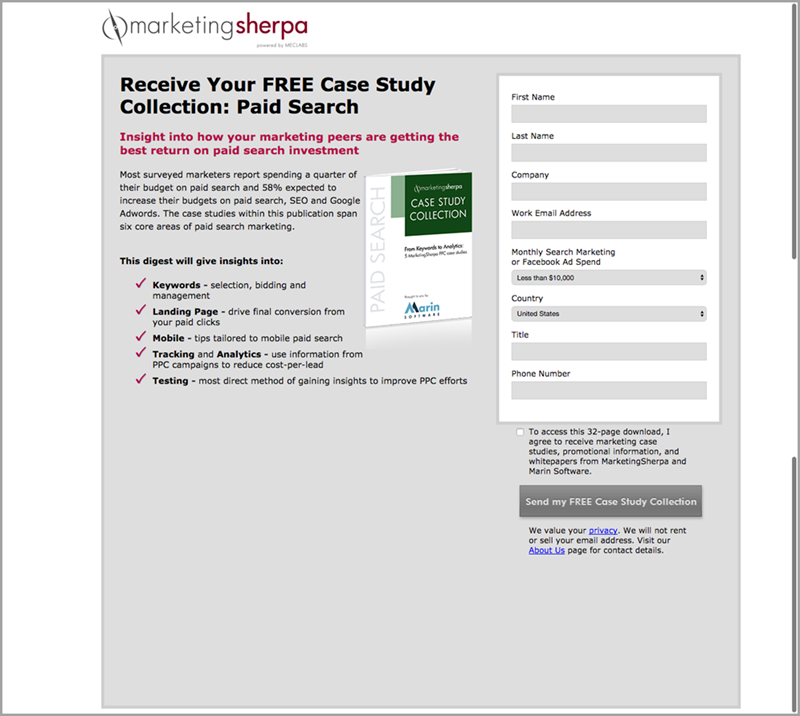
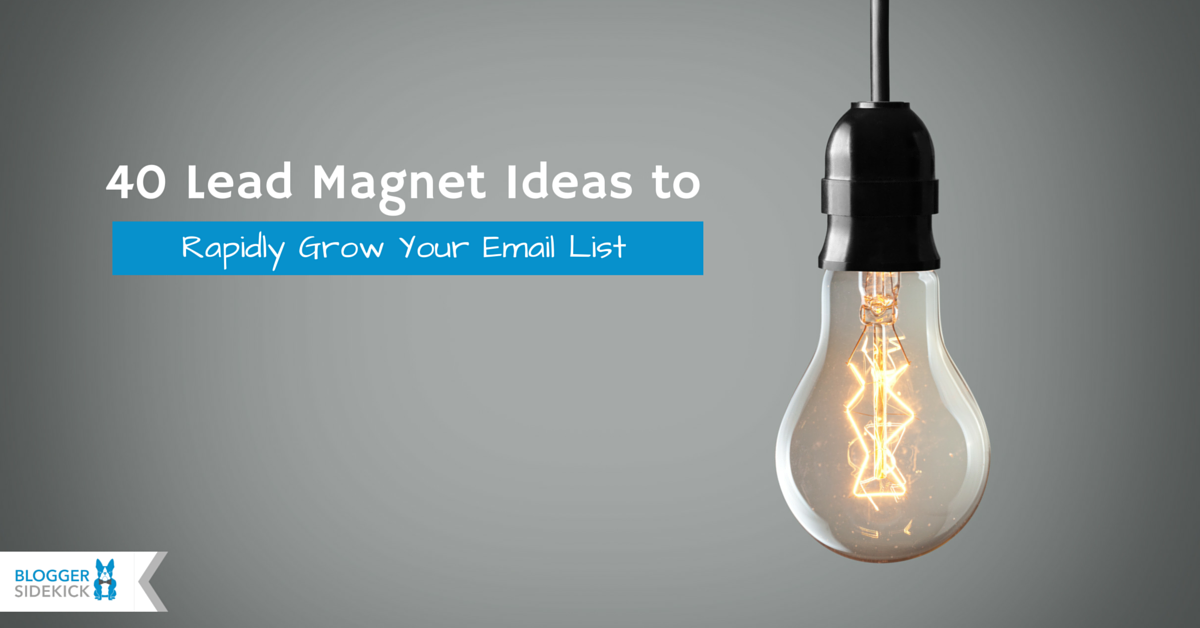
Do you want to grow a crazy-big email list?
You probably should… 85% of people that use the internet communicate via email, compared to only 62% across every single social network combined.
So even if you dominated every social network there is, you’d be falling over 20% short of your online market potential. Can you afford to miss out on that?
The most effective way to convince people to sign up for your email list is to deliver highly targeted and super-specific lead magnets that provide so much perceived value, prospects have next to no choice but to opt-in.
To create these offers of value you need a list of lead magnet ideas ready to implement.
Here at Blogger Sidekick we’ve had 15,000+ downloads of over 15 different lead magnets, and I’ve learnt a little something along the way about what works and what doesn’t. (Not to mention the 50,000+ downloads we’ve been a part of with our clients)
What is a lead magnet?
A lead magnet is a compelling offer, available for free, that entices website visitors to give up their contact information. Usually an email address as a minimum.
It’s like a transaction… Except instead of money being transferred, you’re providing something of perceived value in exchange for the right to contact them in the future. Your job is to sell that perceived value so they are compelled to take action and join your community.
Your lead magnets should ideally be a chunked-down version of your primary product or service. The goal is to give them a taster of what else you’ve got available and the amazing value that could add to their life.
As long as your lead magnet is relevant to your end product, then the focus turns to optimising that lead magnet to maximise the amount of web visitors you convert into subscribers, so you can nurture them into customers over time.
What type of lead magnets convert the best?
As a general rule, the more tailored your lead magnet is, the better it is going to convert.
Let me illustrate that with an example from the Health and Fitness industry.
Let’s say you have written an article about “The 37 Best Ab Strengthening Exercises”.
What most blogs and site owners would do is to create a generic lead magnet (such as an eBook) and slap it on the end of every post that is semi-related to that topic. Something like “How to Burn 20 Kilos in 20 Days”.
If someone has read that article, you can near on 100% guarantee that they are interested in “Ab Strengthening Exercises”.
But that’s it… You can’t assume that just because they are interested in that topic, that they are interested in “losing weight”, “getting fit”, “eating healthy” or an array of other semi-related topics that you may cover in that eBook. They may be interested in ab exercises for a completely different reason.
To illustrate the importance of this, let’s take a look at the conversion rates of some of our lead magnets. The one’s at the top of the image are all “Blog Specific” bonuses, that I’ve called content upgrades.
Below those are the more generic lead magnets that I have featured on our resources page and other places on the site. You will see that for the more tailored lead magnets the conversion rate ranges from 39-71%, but for the generic lead magnets it ranges from 8-26%. That is a HUGE chunk of people that are deciding not to take the bait after they have seen the offer, the only real difference is relevancy.
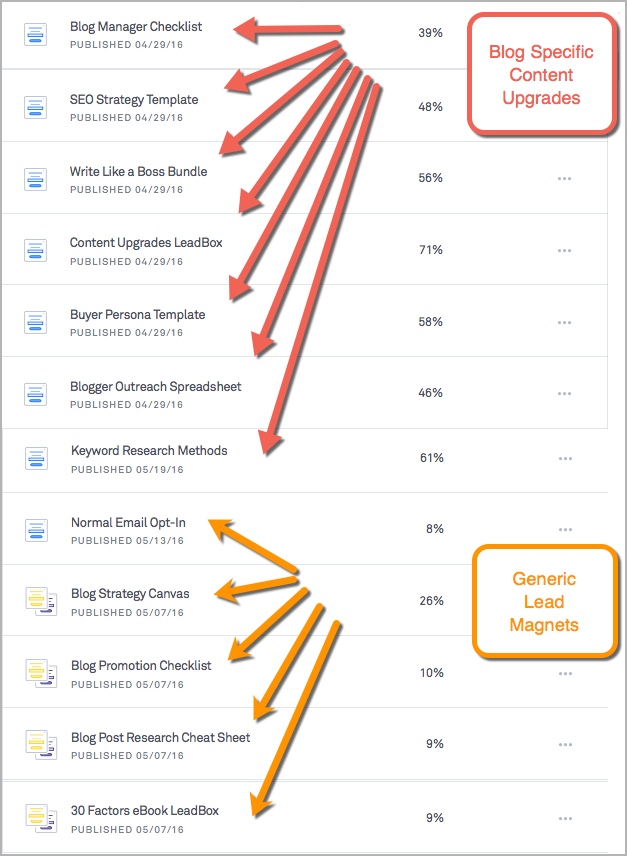
How do you find high-converting lead magnet ideas?
Ok so that’s great… specific and relevant lead magnets work the best.
But how do you come up with lead magnet ideas that are going to convert like this?
I’ve put together a master list of 40 different lead magnet ideas you can use right now to start converting more visitors into leads.
You may like to bookmark this page and whenever you’re stuck for ideas, come back and flick through the list for some inspiration.
For each of the ideas in this list I’ll provide my own unique critique… Because to be frank, I’m not a big fan of every one of them.
But I’ll leave it up to you for deciding which ones make the most sense in your case.
Let’s get into it…
1. Subscribe to our newsletter
The good old “Subscribe to our newsletter” tactic for converting visitors into leads has been done to death… Or has it?
Despite what I said above about relevancy and creating lead magnets that are super-specific and tailored to your content, I still think there is a place for simple signup alternatives such as this.
Why?
Because people like to have a choice. If I like your site and want to keep in touch, give me the option to subscribe without downloading a PDF. Some people aren’t used to downloading tangible lead magnets and actually seek out these basic signup forms.
Problogger’s free newsletter for example includes tips on blogging, tutorials, podcasts, and every month they send 30 writing prompts so that you never run out of ideas for blogging. That’s a pretty compelling lead magnet for someone looking to start a blog;
2. Checklist or Cheat Sheet
This kind of lead magnet is perfect for developing some trust with your followers or new visitors to your site, and they are really easy to whip up.
A checklist for example could simply be a repurposed PDF of one of your list posts, just like I’ve done in these two examples:
- 22 Qualities of a Mind-Blowing Blog Manager (Supported by the “Blog Manager Checklist“)
- 11 Irresistible Elements of a Killer Squeeze Page (Supported by the “Squeeze Page Checklist“)
And a cheat sheet is really just a collection of tips organised in an easily digestible format such as a PDF, usually no longer than a page. Again, you could simply just repurpose the key points of a blog post and deliver it as a tangible download in exchange for someone’s email address.
Below is an example of an SaaS Metrics cheat sheet from Chart Mogul;
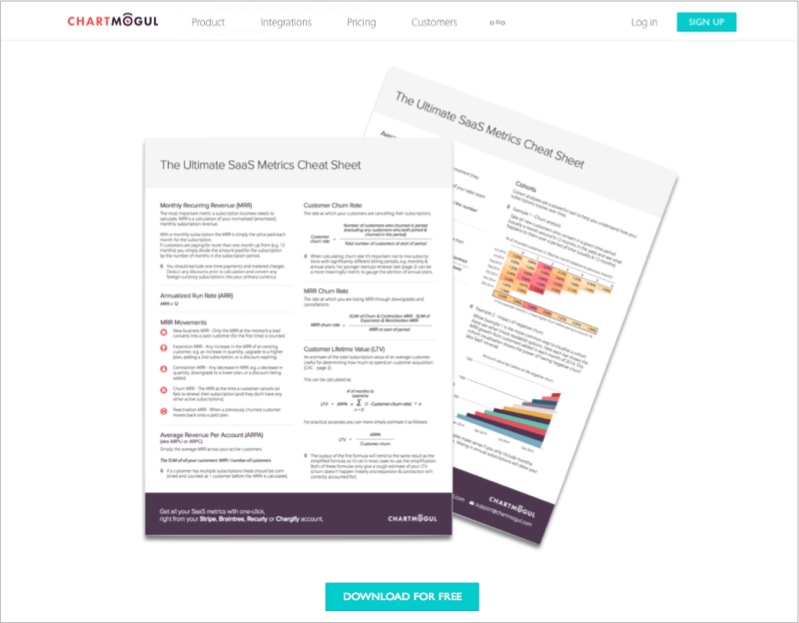
3. Templates
Templates are great because they offer something customizable, such as a “fill-in-the-blanks” or “plug and play” style of download. You can literally take them away and put something in action immediately.
The team at Bluewire Media are the go-to for this type of lead magnet, in fact they’ve built their whole business on the back of it.
To support the launch of their Amazon best-selling book Web Marketing That Works they decided to give away 33 web marketing templates, the very same templates that are now the primary give-away on their site and the structure of their marketing funnel.
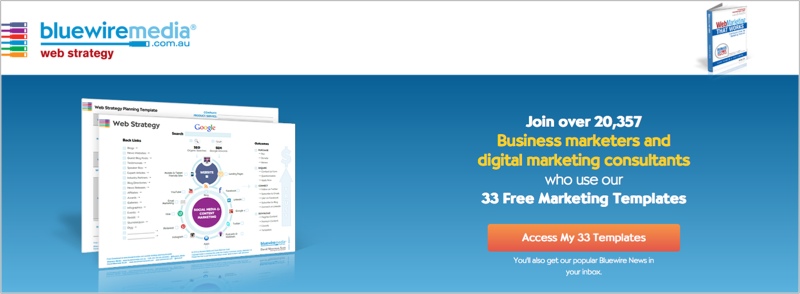
4. Bundles
Bundles are something I started testing about 6 months ago and saw some really awesome conversions, so have stuck with them.
Essentially what a bundle offers is a small group of other lead magnets, perhaps you’ve used them for other purposes, that combine to deliver one specific outcome.
For example, the first ever bundle download I created was on this post about writing quality blog content. We combined the popular “Blog Post Checklist” with a writing template and step-by-step process, all complementing each other to deliver a result for the reader.
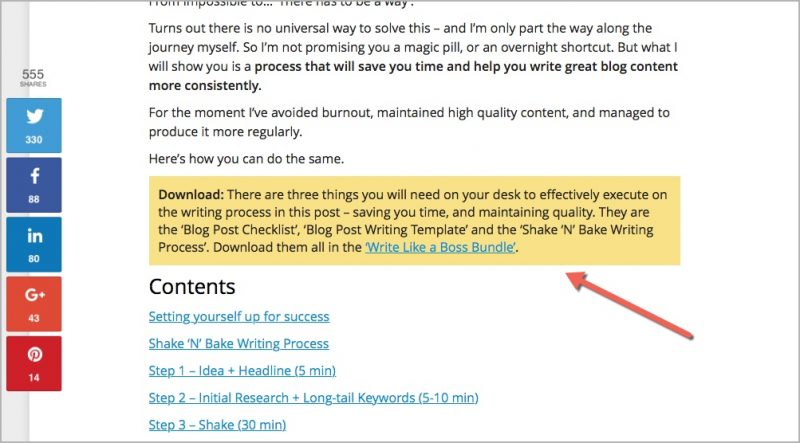
That bundle converted at 56%… For everyone who clicked that link, 56% of them gave up their email address, which is a pretty awesome conversion rate.
Since then we decided to use bundles more often, you may even notice that the primary pop-up lead magnet we have running at the moment is the SEO Content Bundle;
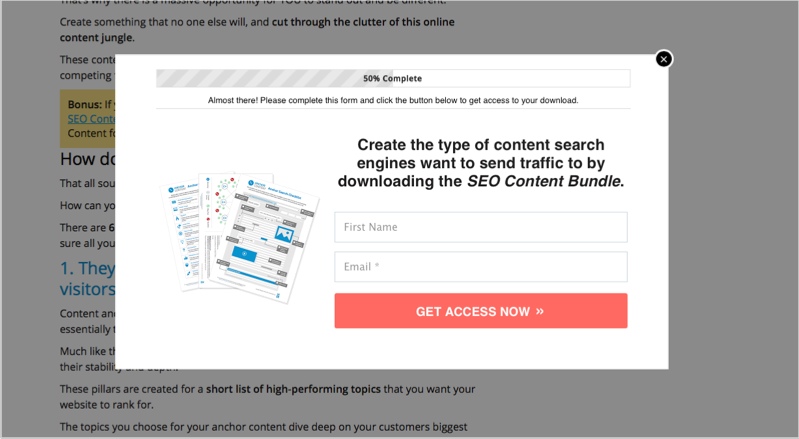
5. E-book
E-books sometimes get a bad wrap… Guilty, I’m often the one doing it!
It’s because they have gone on a revolutionary journey. From the number one way for bloggers to make money online, to a cheap packaged up PDF that people call an eBook and give away for free.
Right back at the beginning of Blogger Sidekick I turned a few long-form blog posts into what I called eBooks;
- 30 Factors to Launch and Run a Successful Business Blog
- List Building – Get More Email Subscribers Than You Can Handle
They weren’t really books and the conversions weren’t that crash hot, so I decided to move away from that strategy. (Conversions for post-specific eBooks are still better than generic eBooks slapped across your whole site though)
However, there are still lots of businesses using eBooks in a very effective way to grow leads. Here’s an example lead magnet opt-in from ReferralCandy;
6. Infographic
Infographics are perhaps the highest-performing piece of content you can create.
They get the most social shares, attract the most backlinks and are perhaps the most easily digested form of content for any audience.
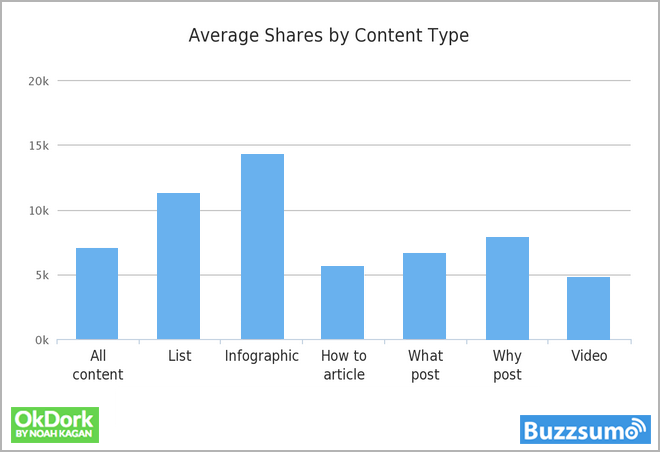
So why not get more out of your infographic investment by offering them as a download?
Pursuant have their infographics available for downloading in exchange for your details, another great lead magnet idea;
7. Toolkit
If people are learning how to do something that you are already an expert at, chances are they will want an insider look at what tools you use.
Be it software or hardware tools, apps, calendars… Create a resource that lists out your “toolkit”, those things that help you get results in whatever it is you do. The tools you can’t live without.
People will give up their email address to get access to that valuable information. Because it saves them the effort of looking for everything themselves, and also helps them understand how you get everything done.
Here is an example of this tactic being used by LeadPages where they are giving away a list of “The 5 Tools I Use To Create All My Videos“;
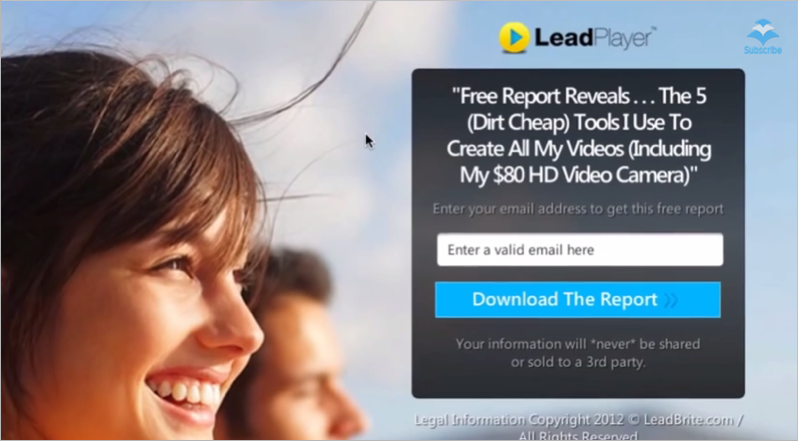
8. Workbook
Just like a template, a workbook is a great lead magnet because it implies action and learning. It’s like the real-world physical workbook you’re given on the first day of a new course or at a conference.
Whilst things like checklists and cheat sheets are great bait, they don’t necessarily inspire action with your audience like a workbook can.
On the flip side, workbooks may not convert as well as the quick and easy sounding checklist, but the people that do decide to opt-in are more likely to take action on your advice. Those that take action are probably more likely to buy, and aren’t these the type of people you want on your list?
Here’s an example from the Content Marketing Institute of a workbook lead magnet;
9. Swipe file
Swipe files are perhaps one of my favorite lead magnets to opt-in for… even though we haven’t offered them at Blogger Sidekick yet.
Basically they are the epitome of a proven, well-tested shortcut to better results. Whether it’s swipe copy for an email, a letter, an advertisement, or something else entirely… the idea that you can take it away, tweak a few words and plug it into your own business is mouth watering.
The team at Digital Marketer generated 28,507 leads in 45 days with their wildly successful “Social Media Swipe File”;
10. How-to or instructional
If you haven’t picked it up already, the common theme with most of these lead magnets is a shortcut. If you can offer your audience a resource that gets them somewhere faster, and is proven for quality, then you’re onto a winner. The how-to or instructional lead magnet is no different.
These lead magnets provide a step-by-step process or sequence of content that delivers a desired outcome to a prospect.
Here is an example from Become a Blogger where they offer a “Blog Business Blueprint” instructional course. It works well because it requires little time (a shortcut) and it’s a proven formula;
11. Guide
So what’s the difference between a guide and an eBook?
Well a guide is typically more diverse in it’s content delivery. For example, an eBook will provide valuable content about a subject predominantly in written form.
A guide on the other hand is more like an old school brochure or magazine, it’s usually created with a variety of different visuals packed into one nice looking downloadable gift.
Guides help you plan ahead for an experience or get to know more about a topic or place, rather than learning “how” to do something.
Here is an example from The National Park Foundation;
12. Whitepaper
Whitepapers might seem old fashioned, but they offer a unique way to standout from the crowd.
With online marketing moving more and more towards speed of execution, if you can’t get a lead magnet up in a day or two then it’s considered not worth doing. Whitepapers take much longer to create.
They are the business version of a university research paper, backed by years of experience and analytical research. Typically they will offer unique opinions, original data points and a deep dive view into a specific industry topic or debate. They certainly aren’t a “how-to”, but they provide food for thought and a progressive look into the future of an industry.
If your industry is embedded with rich history, or predominantly deals with baby boomers and traditionalists, then a whitepaper is a very compelling lead magnet. They are prominent in professional services, industrial, mining and healthcare industries.
Here is an example from the IBM Marketing Cloud service;
13. Calendar
Calendars can provide a huge amount of value to your audience.
Regardless of your industry, your customers probably need to plan out their year. Be it an editorial calendar, sales pipeline meetings, shopping and travel plans, or anything else… You can create a pre-populated calendar for them.
It saves time for your audience because they just need to tweak, set and forget.
In the below example, ThriveHive are giving away a 2016 Marketing Calendar which helps small businesses with their entire marketing strategy;
The best time for these yearly calendars is going to be November, December or January… But you can get creative.
How about a weekly planner you could offer all year round? Or perhaps a “Getting ready for the holiday season rush” calendar for eCommerce businesses.
If you think a calendar or planner is a good lead magnet idea, then you don’t have to limit yourself.
14. Free video series
This is another common lead magnet for many online businesses, the video series.
Creating a video series obviously takes a lot more time and effort than throwing together a cheat sheet or template, but the long-term benefits can be impressive.
Most businesses that use a video series as their indoctrination sequence do so to nurture leads into customers with a very specific journey. So if you get it right, it can be the gift that keeps on giving.
The team at Marketing Results sell predominantly to high-end service businesses and use a video series to help prospects “Double Leads In 30 Days”. Because their target market is considered to be “high-end”, the extra effort put into a video series helps them stand out to prospects.
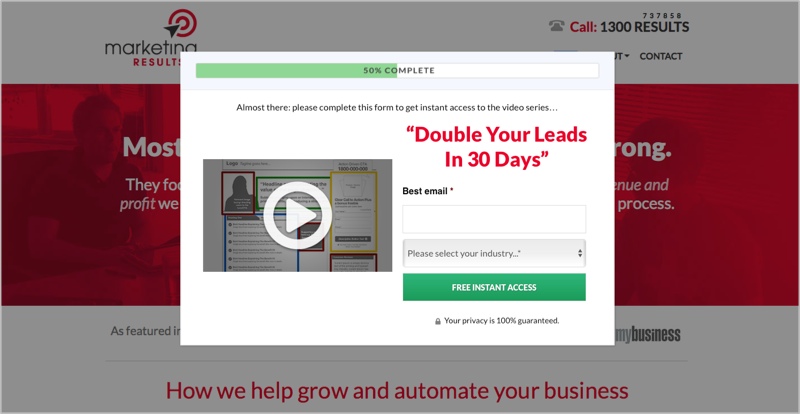
Here is another example of a video series lead magnet from Dr. Wayne Dyer. You can see the benefits of the video series are laid out clearly, and the perceived value for the audience is exponentially greater than the small exchange of an email address;
15. Mini e-course
A mini e-course can be a quick and easy lead magnet to throw together. Because the term “e-course” is really just a fancy way of saying email sequence. It’s a re-framing of the same deliverables that people are most likely getting when they signup for your “Newsletter” or “Weekly Updates”. But the term course suggests learning, and something of bigger value than a few emails, so it’s a smart way to convince people to sign up.
Below is an example of a “7 Day eCourse” from Kim at Your Chic Geek;
16. Teaser of an online course
Do you sell an online course? It may be worth giving away a teaser of the course as a lead magnet to grow your subscriber list.
The genius of a teaser, or preview of a product, as a lead magnet is that you are preparing prospects for a future purchase. Also, you can guarantee that anyone that takes the bait is definitely interested in that topic, or in overcoming the problem you solve in your course.
The key to a teaser is that you giveaway enough that it has a LOT of perceived value, but not too much that your prospects aren’t craving more.
Here is a course preview example from Mind Body Green (MBG);
17. Free version of full e-course
A subtle variation on the “teaser” lead magnet is to giveaway your online course for free…
Sound crazy?
Well it kind of is, but not if you are confident that the course itself will be able to hook users in.
The idea of the “Free Version” of a full e-course is that you get people in the door, once they are in the door they are less likely to leave.
It’s just like a free trial for a software product; get people to sign up, perhaps even enter their payment details, and give away the course for FREE for a short period of time. Let’s say 14 days as an example.
The Centrifuge is an only library of resources for Entrepreneurs that offer a variety of free courses and a paid version, they are letting you see what’s under the hood for free so you end up purchasing the whole nine yards;
Fizzle, also an online business community, is another great example of this tactic;
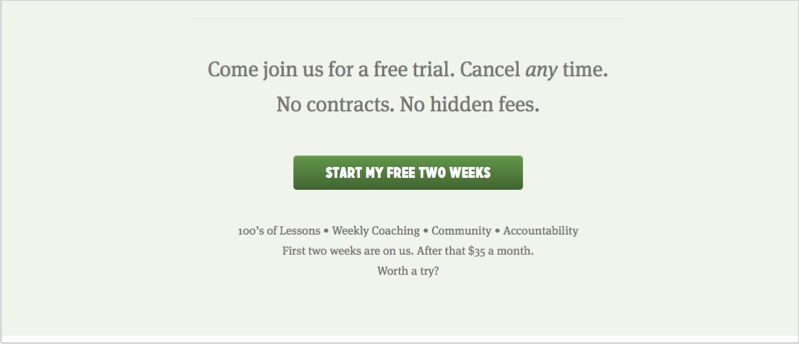
18. Free chapter of an upcoming book
If you’re an author, or planning to become an author, then this strategy is a great way to build buzz for your book and generate leads in the process.
The compelling part about offering early access to a new book is that it creates a feeling of exclusivity. People want to be a part of the cool early adopter club and the first to know about something.
Giving away a free chapter is also a great way to boost pre-launch and post-launch book sales. For example you could offer people that downloaded the free chapter a coupon or discount for the full version.
Lean Stack’s Ash Maurya has used this tactic for his book “Scaling Lean“;
19. Event or webinar recording
If you go to the effort of running an event, online or off, you may as well milk it for everything it’s worth.
Recording your event and making it available to people at a later date, in exchange for their details of course, is a widely used and highly effective lead magnet strategy.
KISSmetrics offer a library of different recorded webinars that are available to prospects, like this one from Thue Madsen;
20. Members only content
Members only content is somewhat of a polarizing topic…
On one side of the argument, people believe that the essence of content marketing is about providing so much perceived value and helpful content, that it builds enough trust with prospects for them to eventually become a customer.
The flip side of that is that if you give everything away for free, what else is there? Why would anyone pay for information beyond that?
There’s no perfect answer to that question, but here’s my take on it…
If you sell information as a business, such as online courses, even if you give away lots of content for free (like I do) there are still people who want to pay for the step-by-step guided tour for implementation.
If you sell other products or services, giving away information doesn’t hamper your chances of landing a customer, it only improves them.
For either business model, there is still an opportunity to reward those that are willing to give up their contact information with your best content.
Why should you waste your time with site visitors that aren’t willing to take action? That aren’t willing to trust you with their contact details?
Copyblogger does a great job with this lead magnet tactic…
They give away a ton of free content on their blog, but if you want the whole shebang they also have a HUGE library of gated content;
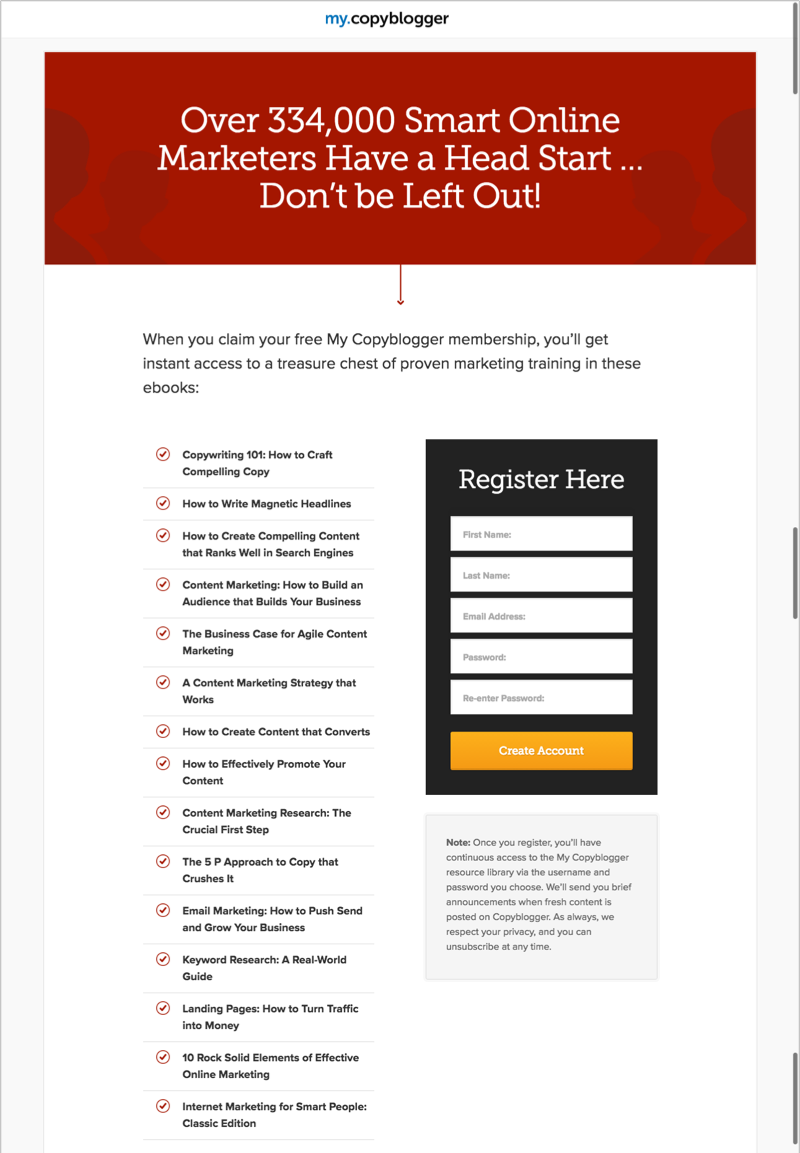
If you’re looking for a quick solution to “lock” your content from non-subscribers, OptinMonster have released a new feature that allows you to gate content and blur parts of it out for non-subscribers.
21. Access to a private Facebook group
In a similar tone as gated content, private forums or groups are a way to provide extra value to your audience in exchange for their email address.
Anyone that signs up for your private Facebook group gets “behind-the-scenes” access and content that isn’t publicly available.
Facebook is also a really quick and easy way to communicate with these die-hard tribe members, and connect them with each other.
Here is an example of the “Social Network Marketing Academy“ Facebook group from John and Nadya Melton;
22. Downloadable resource package
Can you think of something that your audience regularly needs time and time again?
In the digital marketing and blogging industry it’s essential to have high-quality images on tap so you can use them whenever you need to. So in this industry, a downloadable file jam packed full of images would be a really intriguing lead magnet offer.
Or this example from Creative Booster, where they offer a mega collection of Infographic vector images;
And this example from HubSpot that offers “50 Examples of Brilliant Homepage Design”;
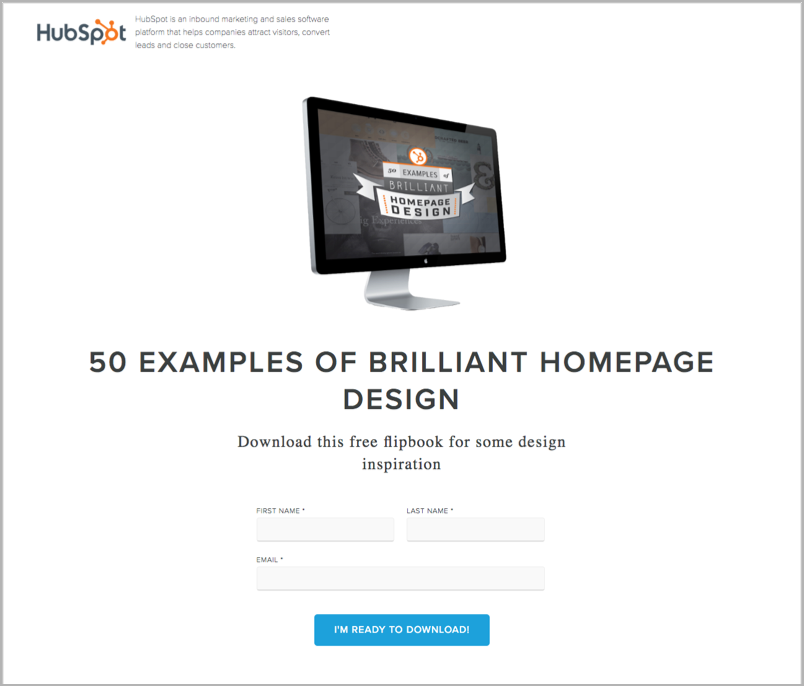
What does your audience need on tap every day that you could package up and giveaway?
23. Repetitive process collection
Does your ideal customer need to do something mundane over and over again? How can you help them change it up and make it more interesting?
This is where a process collection lead magnet can be a great temptation.
For example, in the health and fitness industry you might offer a “The Ultimate Collection of Strength Training Exercises for Basketballers”.
Or in the fashion industry, “The Mega-Collection of Summer Fashion Styles for Men in Their 20’s”.
Here is an example from Food & Wine where they have offered a collection of Earth Day recipes. Using a time-specifc and seasonal lead magnet can create increased interest and urgency;
24. Free consultation
I’m not totally sold on the “Free Consultation” as a lead magnet idea… Because I think it’s too big.
People are more likely to opt-in for something they can check out in their own time that doesn’t require a big commitment.
Once they opt-in for something smaller such as checklist, resource package or video series, then you can nurture them over time to be ready for a consultation.
Plus, I think people understand that a consultation is essentially a sales call – so don’t wrap it up as something different.
That being said, if you’re looking for only the highest possible quality leads that are ready to buy NOW, then that’s what you’ll get with a free or paid consultation.
Here is an example from Collaborada for a “Free Marketing Consultation“;
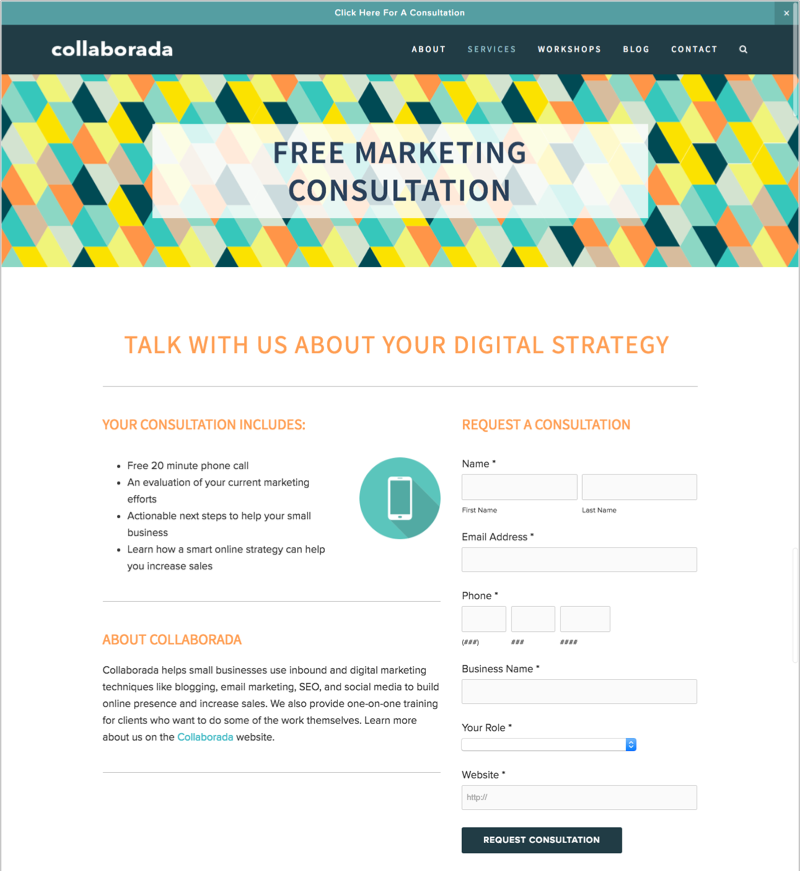
25. Survey or Quiz
More and more surveys or quizzes are being used to entice prospects to opt-in to a subscriber list.
The intrigue for a prospect in a survey is usually what’s offered on the other side of taking the survey.
“Find out what your peers said about [Topic X]” or;
“Get specific and actionable advice about [Problem Y]”
If you’re going to use a survey or quiz as a lead magnet the key is to make it short and fun, with a high perceived value piece of advice or information on the other side of the door.
Here’s an interesting use of surveys from the UPS Store and their “Score Marketing Cookbook” for entrepreneurs;
26. Contest
Contests or giveaways can rapidly grow your subscriber list.
The concept is pretty simple, you offer a prize of high perceived value to your ideal customers, and they give up their contact information to “go into the draw to win”.
Here’s an example contest from Sandals to win a holiday;
If you’re looking for a quick, easy and nice looking way to run a contest on your WordPress site – check out KingSumo giveaways;
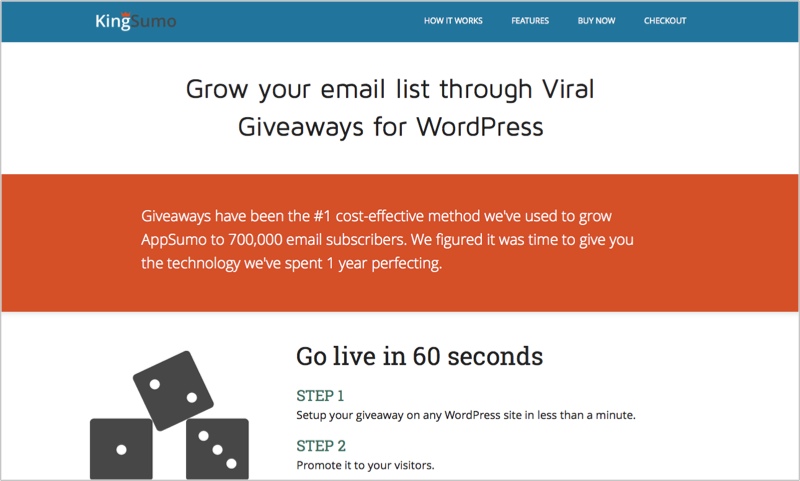
27. Sample
Samples are kind of like the “teaser” lead magnet for eCommmerce or product based businesses.
Just like with a teaser you’re giving customers a preview of the quality of your offering, with the goal of turning them into a long-term customer because of it.
The team at Try The World is a subscription service for chef-prepared food boxes. Their primary lead magnet is a “Free Box” to kick the relationship off.
28. Weekly deals
Weekly deals are another lead magnet idea that is prominent in the eCommerce industry.
The goal of weekly deals is really to encourage repeat purchases from loyal customers. If you are a regular shopper at a store then it’s a win-win for the business and the consumer, because they get more sales and you get your products for better value.
Here’s an example from one of the world’s biggest retailer’s Target;
29. Coupon
Exclusive deals for community members and subscribers is another great way to grow your email list, especially if you are an eCommerce business.
The basic idea is that someone joins your list and in return they get “X%” off a purchase, or an “$X voucher” to use in your store.
I don’t know about you but if I’m about to buy something from an online store and they’ve got a discount on the table, I’ll take that deal!
Here is an example from Mod Cloth who offer 20% off purchases over $100 for new subscribers;
30. Free shipping with an order
Another killer lead magnet idea for an eCommerce business is to offer free shipping with an order…
But don’t just give it away, get the contact information you need in return.
It’s a win-win because your customer wants free shipping, so they’ll give up their email address to get it.
Plus, you can communicate to them in the future once they are signed up.
Under Armour is a well known brand that uses this tactic to grow their subscriber base, see below;
31. Free trial subscription
Subscription services regularly provide free (or really cheap) trial periods so customers can get used to the service before buying.
They make for great lead magnets because it is an exact replica of the final service offering. Which means if people like what they see, they are very likely to continue on with the service and pay the fee.
Spotify use this tactic really well to not only grow their subscriber base, but also turn more prospects into paying customers.
Their 30-day free trial for a premium account has high perceived value for minimal commitment;
This concept also works for software products such as CoSchedule’s 14-day trial below;
32. Software tool
Who would of thought that businesses would be giving away free software tools one day?
It’s kind of crazy, but is happening more and more often as technology and access to developers improves across the world.
If you can develop a piece of software that is easy to use, provides a very specific outcome for your prospect and captures their details in the process, it’s likely to be a winner.
HubSpot’s blog topic generator is a great example of a free software tool;
33. Analysis or audit
A free, easily generated analysis or audit of something is another compelling way to entice opt-ins.
For example, if you have a software business that offers analysis of some kind… Let people check it out for free if they sign up, and get an initial analysis of whatever it is you analyze.
There are tons of examples of this tactic used in the marketing industry, especially with SaaS companies.
SEMrush, for example, let you take their software for a test drive by analyzing the traffic data associated with your website. But they don’t reveal all the goodies unless you give up your email address;
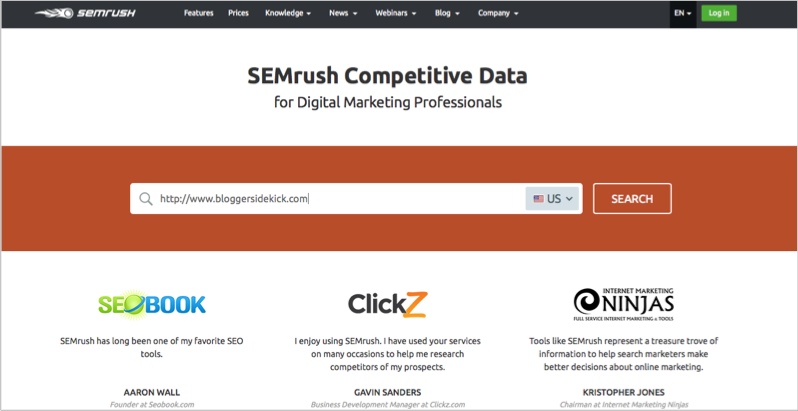
HubSpot have a website grader…
And another example is this content analyzer from Neil Patel’s Quick Sprout blog;
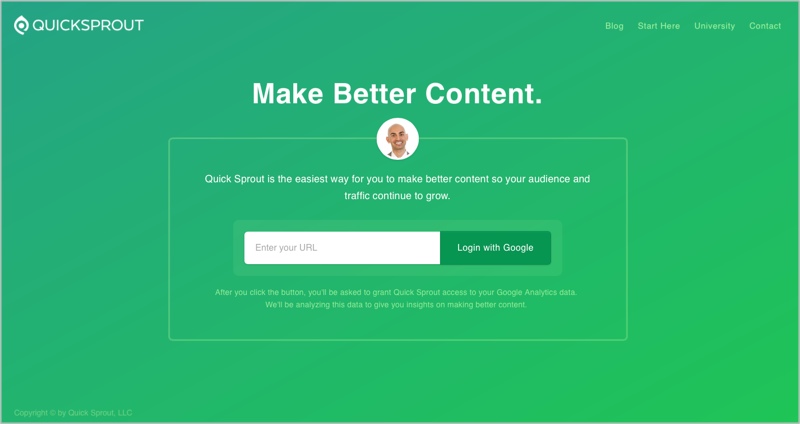
34. Manifesto
A manifesto is kind of like a guide, eBook and whitepaper all rolled into one.
It’s a gigantic resource that shares experiences, stories, statistics and advice on doing something extremely well.
A well executed manifesto can establish your brand as an authority in your industry.
Danny Iny from Mirasee (formerly Firepole Marketing) shares his “10 Rules of Visionary Business” in this manifesto that reveals the secrets behind his success;
35. State of industry reports
Industry reports position your brand as a market leader.
You are telling people that “We are the authority in this industry, and we are providing you the important industry insights you need to know”.
People always want to stay informed about their industry and about what their peers are doing, and this style of report is a great way to leverage that desire.
Usually industry reports will be released once a year and be backed by a large market research project in the industry.
For example, Social Media Examiner produce the “Social Media Marketing Industry Report”;
And the Content Marketing Institute collaborate with MarketingProfs to create the “B2B Content Marketing Benchmarks, Budgets and Trends“ report.

36. Expert roundup
Next on the list is the expert roundup…
There is definitely a trend at the moment for these expert roundup posts, and I’m not sure I’m sold on their value.
“147 Experts Reveal What They Eat For Breakfast”
“79 Influencers Tell Us How They Walk Their Dog”
I mean seriously, I get that they generate lots of social buzz because all the contributors share the post around, but how much value is there in it for the reader?
Do you really think anyone is going to sit there and read through every piece of advice in that list? It’s unlikely, and it does little to push your prospects down the sales funnel.
I won’t lie, I contribute to them because it’s an easy bit of exposure and a free back link. But would I ever do one at Blogger Sidekick? Probably not.
Anyway, if it is your thing then you might want to turn your gigantic list of expert advice into a lead magnet.
Contently does it here with their 150 tips from marketing experts that will “inspire”:
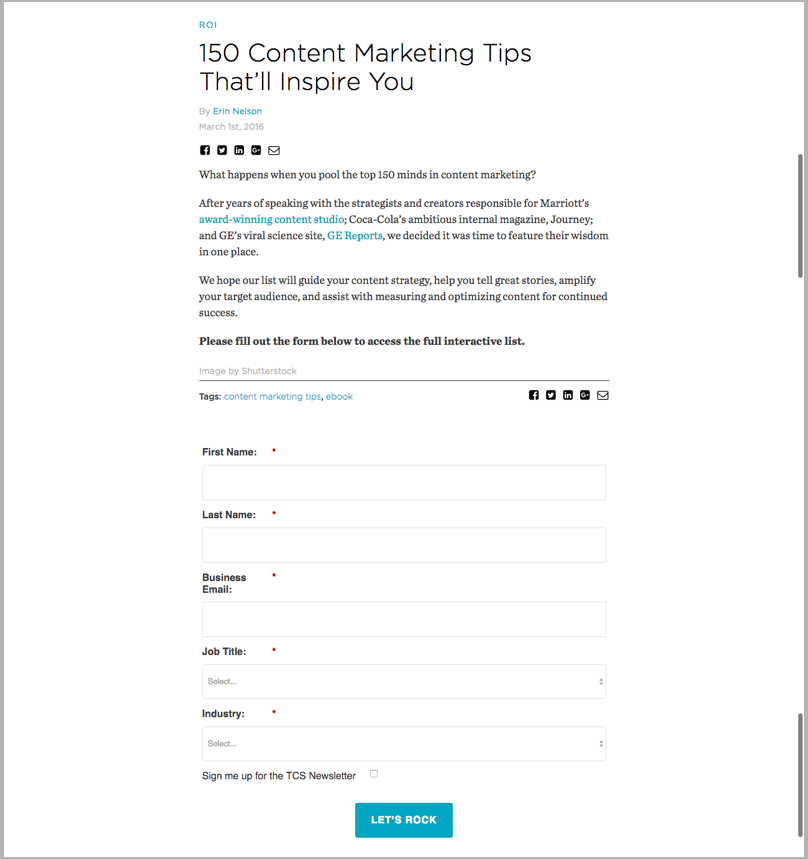
37. Library
A “Library of Resources” is really just a different way to package up content for your prospects. I know I’m mentioning HubSpot again, but they are just gurus at this lead magnet stuff.
You can see all of the videos in their epic “Marketing Resources Library“ but have to enter in your email address to access them;
Another cool resource library, but I don’t think they use it as well as they could as a lead magnet, is AdEspresso’s Facebook ad library. If you sign up for their free trial they have a library full of successful Facebook ads from businesses in just about every niche.

38. Vault
The vault is a bit like a library of resources, but it’s not as up to date and recent.
It really only works in businesses where you have a publication or a big list of un-published content and want to make it available to the public in one easy place.
For example, Yoga Journal has a vault of every issue of their magazine from the last 10 years that they use as a lead magnet;
39. Facts and statistics
For some reason we are drawn to facts and statistics… They make us click, and entice us to share.
Perhaps it’s because statistics are significantly easier to remember than tips or how-to’s, so they empower us to share our experience with other people.
This collection of helpful (must-know) statistics from Emma (an email marketing boutique) contains digestible and shareable information that prospects can download and takeaway;
40. Case studies
Last, but certainly not least on the lead magnet ideas list is case studies.
Case studies are a money-making piece of collateral in your marketing armoury, because they take fence-sitters and turn them into customers.
But the cool thing about case studies is they are more than just the final piece of the puzzle in your marketing funnel, they can also inspire prospects who are much higher up in the funnel to move much quicker.
A well constructed case study can put a prospect in the shoes of a success story, making them feel much closer to success than they thought they were. And people crave this type of inspiration. They want to see how other people have done exactly what they are trying to do before.
So if you package up a list of compelling case studies, with usable and relevant information, they can be used as a lead magnet.
Here is an example from Marketing Sherpa who have a collection of “Paid Search” case studies on offer;
Closing
It would be inefficient to go away and try to create every single one of these lead magnets…
But have a think about this;
- What type of lead magnet(s) can you create that will accelerate a prospect’s journey towards becoming a customer?
- Once you’ve got that nailed, how can you get MORE of your ideal prospects seeing your lead magnets?
- Finally, how can you increase conversions so that more of those prospects are taking the bait?
If you do those three things, your lead magnet strategy alone will tie in nicely to your greater business goals.
But if you skip a step, or take a shortcut, the chances are you’ll be offering low-converting or irrelevant lead magnets and wasting a bunch of time in the process.
So don’t look at this list as an opportunity for distraction, see it as an opportunity for challenging yourself. Asking the hard questions about your current strategy that you’ve been avoiding. Then making the changes you need to make in order to grow your business.
What have I missed, what other lead magnet ideas have been winners for you?

